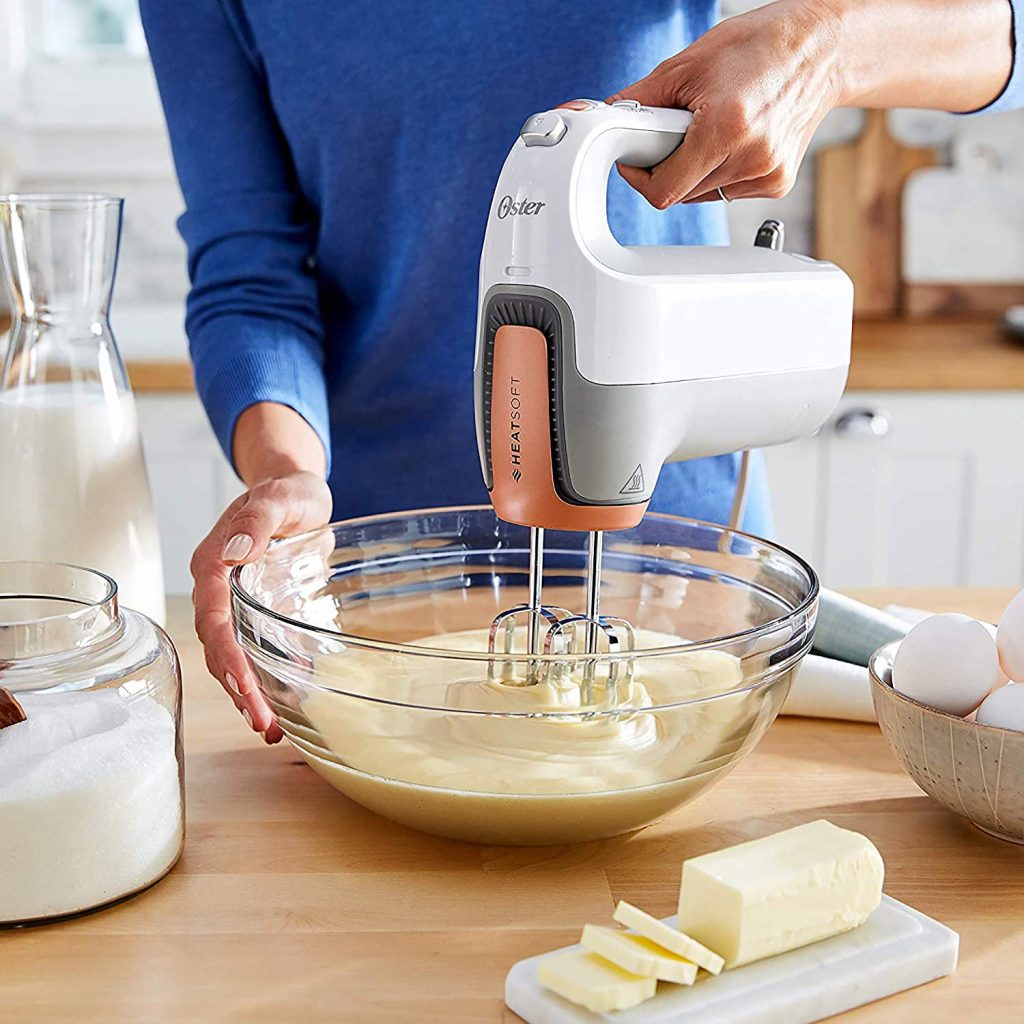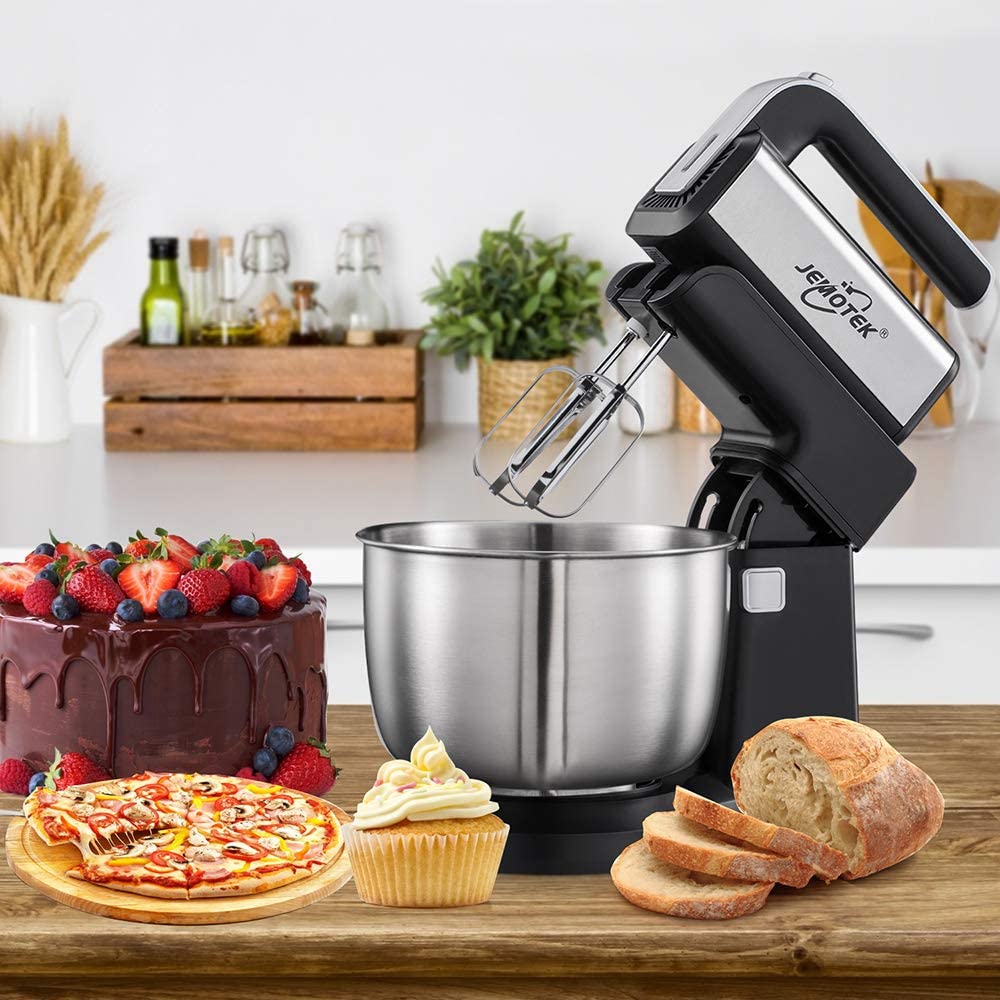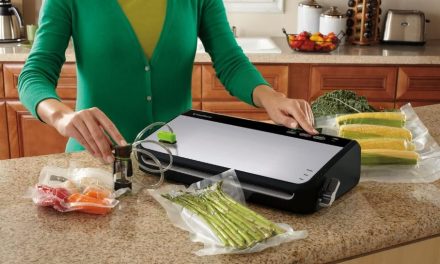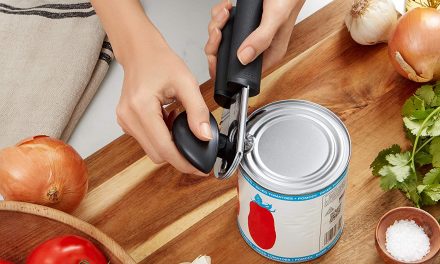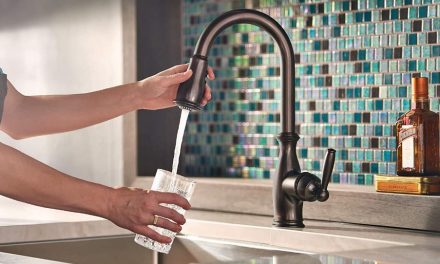Electric mixers take the hard work of whipping cream, making meringue, creaming butter, and kneading dough off your hands. For nearly a hundred years, hand mixers and stand mixers have made a variety of foods more accessible to the home cook. In this article, we’ll take a look at the different kinds of electric mixer and find out which is best for you.
Hand mixers are good for most kitchens
Hand mixers have a base with a handle, two ports that can hold a variety of attachments, and usually several speed settings. You simply plug the attachments into the base, turn the mixer on, and you’re good to go.
Hand mixers are a great option for most home cooks. They can’t knead bread dough as well as a stand mixer, but for most day-to-day tasks, like mixing batters and whipping cream and egg whites, a hand mixer works just as well as a stand mixer, if a little slower. For many home cooks, a smaller, more portable hand mixer might even be preferred, and cleaning is a bit faster. You can also mix in whatever bowl you want.
A major downside of hand mixers is that you’re usually limited to beater, whisk, and dough hook attachments, but beaters are all you need for cakes and cookies, whisks make short work of whipped cream and meringues, and dough hooks handle all manner of stiffer doughs.
Immersion blenders work similarly to hand mixers (and are also handheld), but while they take chunky mixes and make them smooth, hand mixers are better for combining ingredients and whipping air into mixtures. There are also manual hand mixers, sometimes called egg beaters, which have a hand crank instead of a motor.
Hand mixers and bread dough
Since many hand mixers now come with dough hook attachments, you might be wondering if you can knead bread with a hand mixer.
Well, you definitely can, but it won’t necessarily be easy. For best results, stick with wetter, softer doughs in smaller amounts. It’s not really a matter of power (most higher-end hand mixers won’t burn out trying to knead dough), but since you have to hold onto the mixer while it’s kneading, it still requires both effort and technique. For best results, start on a low speed until the dough forms into a ball, then move to a higher speed until the dough is smooth and elastic.
Bottom line? If you’re interested in kneading dough regularly, or making large batches of cookies, large cakes, or any other heavy load, invest in a stand mixer instead.
Like to cook and bake? Consider a stand mixer
A stand mixer takes the convenience of a hand mixer into hyperdrive. Not only does it mix for you, it also holds the mixer for you, allowing you to walk away while it does its job. Basically, a stand mixer consists of a stand that holds both the motor and the bowl.
The most important advantage a stand mixer has over a hand mixer is the increased power. A good stand mixer can knead bread dough and mix stiff batters with ease. In addition, you don’t have to babysit a stand mixer the same way you do a hand mixer. It makes adding ingredients while mixing much simpler. They’re also easier to operate physically, requiring less effort and technique, which might be a bonus. They are usually heavy, though, so depending on design they can be difficult to operate. They also take up a lot of counter space and can be harder to clean than hand mixers.
Stand mixers, like hand mixers, tend to come with (or at least have the option of) a variety of attachments with additional uses. Hand mixer attachments simply can’t match the capabilities of stand mixer attachments. With the right attachments, stand mixers can actually work as a variety of other appliances.
While several companies manufacture stand mixers, KitchenAid is the industry leader in the stand mixer market, including for commercial models. As a bonus, their mixers are always assembled at their factory in Greenville, Ohio. But why have KitchenAid stand mixers topped most best-of lists for so many years?
- Intuitive design
- No matter the style of Kitchenaid stand mixer you choose, functions like installing attachments, choosing mixer speed, and removing the bowl are easy and simple to do
- Even mixing
- KitchenAid stand mixers require less bowl scraping and additional mixing
- Bowl shape, rotation style, and attachment design all contribute to more even mixing
- Narrow attachment clearance
- One of the most important factors of even and consistent mixing
- Whatever attachment you choose should come in contact with all parts of the bowl
- Powerful motor
- While some other brands boast about their wattage and horsepower, the real test is torque
- A well-torqued motor maintains consistent speed across a variety of scenarios
- Motor stalling is the most common cause of motor burnout
- Heavy
- The lightest KitchenAid stand mixer weighs in at eighteen pounds, and the heaviest is more than thirty
- A heavier stand mixer means more solid construction
- A heavier mixer is also less likely to shake and move during operation
- Well-designed attachments
- Wider-profiled balloon whisk whips air more effectively into thicker mixtures
- Wing-shaped flat beater effectively creams and mixes while the wide gaps prevent clumping
- Solid, simply shaped dough hook effectively combines ingredients and forms them into a ball while handling the stiffest of doughs
- And these are just the attachments that come with a KitchenAid stand mixer. No other company has a wider selection of different optional attachments!
Not ready to invest in a KitchenAid mixer? Check out other bestselling standmixers, many of which are more affordable.
Best KitchenAid stand mixers
- Best overall: The KitchenAid Artisan. With a five quart (4.7 L) stainless steel bowl, complete with handle and pouring shield, you can handle everything from meringues to baguettes. The artisan brings a professional feel to a mid-range price and is the top choice of thousands of happy customers, including Andrew Rea of Binging with Babish fame.
- Best budget: The KitchenAid Classic Plus. It’s a bit smaller, at 4.5 quarts (4.3 L), but it can do nearly everything the Artisan can do and it does it all for less than three hundred dollars.
- Best compact: The KitchenAid Artisan Mini. It’s got the smallest bowl on the list, with a capacity of only 3.5 quarts (3.3 L), but what it lacks in size it makes up for by packing nearly the same power of the larger models with a 20% smaller counter space footprint.
- Best for bread: The KitchenAid Professional 600 Series. Never worry about motor burnout no matter how tough the dough, and KitchenAid’s powerknead spiral dough hook will ensure amazing results every time. Its 6 quart (5.7 L) capacity and bowl-lift design are just icing on the cake.
- Best for large quantities: The KitchenAid 7-Quart Pro Line. With a 7 quart (6.6 L) capacity, make large batches of the thickest doughs with ease. Its bowl-lift design makes sure the stand won’t shake through the toughest designs, and it holds up to sixteen cups of flour!
All these models come with beaters, dough hooks, and whisks, as well as KitchenAid’s standard multipurpose Power Hub for additional attachments.
Repairability
The KitchenAid factory in Greenville, Ohio offers high-quality, well-informed customer service as well as shipping kits to safely (and cheaply) transport your mixer to the factory for testing and repair.
If you’d prefer to fix your mixer on your own, replacement parts are widely available online, and there are plenty of videos and instruction guides around to help you do so.
Bowl-lift vs. tilt-head

A bowl-lift mixer (left) vs. a tilt-head mixer (right). Both featured are manufactured by KitchenAid.
Bowl-lift stand mixers feature a bowl suspended over the base of the mixer. The bowl is removed by unlatching it and pulling it down around the attachment. The stand is one solid piece. In tilt-head stand mixers, the bowl sits on the base, and the stand is hinged. The bowl is removed by tilting the head of the stand and the attachment up and away from the bowl.
KitchenAid only offers bowl-lift style mixers for their professional and commercial lines, meaning they’re more expensive. Fortunately, you can find more affordable refurbished models through their website. You may also be able to find smaller bowl-lift stand mixers from other brands. The bowl-lift design is preferred for high-powered models because the stand is less likely to shake, but they’re harder to use, often messier, and are less likely to fit under standard-height kitchen counters.
The choice is up to you, but for our money, we’d suggest tilt-head stand mixers unless you’re looking for serious power.
Other stand mixers
KitchenAid is the industry leader in stand mixers for a reason, but if you’re not convinced or you’re not sure about the price, here’s what to look for from other bestselling stand mixer brands:
- Make sure the stand mixer is heavy. This can’t be said enough.
- Torque is more important than horsepower.
- Bowl capacity may not be the most important thing. No model makes full use of the bowl.
- Bowl shape and composition are important. Aim for stainless steel unless you want to be able to put the bowl in the microwave. A handle is helpful if you’re going to deal with heavy or sticky mixtures. Splash guards are also helpful, though lids can make adding ingredients and keeping an eye on your mixture harder.
- Find out if the bowl (and any attachments) are dishwasher safe.
- Consider your noise tolerance levels. Many stand mixers are loud when in use.
- Other helpful additions are timers with automatic shutdown and a slow start mode to avoid messes.
- Most importantly: Does the mixer do everything you want it to do? For many people, a cheaper, less powerful stand mixer might be all they need, but if you want to knead bread dough or handle large amounts of cookie dough, considering investing in a higher quality mixer.
Hand stand mixers (2-in-1 mixers)
For the convenience of a hand mixer with the versatility and ease of use of a stand mixer, try a hand stand (or two-in-one) mixer combo. They’re cheaper than dedicated stand mixers but still allow you to walk away while they’re mixing. The detachable hand mixer means you can mix whatever you want in a different bowl if you like.
Unfortunately, they do suffer from the same issues as hand mixers, so if you’d like to tackle stiff bread dough or large amounts of cookie dough, the power of a stand mixer is still a better option. Try the Hamilton Beach Classic Hand and Stand Mixer for a good budget option, or the Breville Handy Stand Mixer if you’re willing to sacrifice a bit of affordability for power.
Stand mixing vs. hand kneading
Now that we’ve established that you can knead bread in a quality stand mixer, the next question is should you. Or, more specifically, can stand mixer kneaded bread dough measure up to bread dough kneaded by hand?
Short answer: Yes!
Long answer: The highest quality stand mixers won’t be able to beat the best kneaders, but for good, consistent results and way less elbow grease, using a stand mixer instead of kneading by hand is a no brainer.
- The food grinder includes fine, medium, and coarse grinding plates as well as two sausage stuffer tubes. Great for fresh meat, hard cheeses, and bread crumbs. You can even get a strainer attachment for fruits and vegetables.
- The food processor includes a wide feed tube for less prep work. Its ExactSlice system ensures consistent results every time, and it also comes with a shredding disc and a julienne disc. Do everything you could with a stand-alone food processor.
- The grain mill grinds low-moisture grains from coarse to fine. Make up to ten cups of homemade flour at a time.
- The ice cream maker also makes gelato or sorbet. This attachment replaces the mixer bowl and makes up to two quarts of frozen dessert in less than half an hour.
- The pasta press includes six quick change discs for bucatini, rigatoni, fusilli, and large or small macaroni, while the pasta roller has eight thickness settings to make everything from dumplings to lasagna noodles to spaghetti and fettuccine.
- Make baking even easier with the sifter/scale. Measure your ingredients by weight while the hopper slowly sifts them into the mixer bowl.
- The slicer/shredder comes with three sizes of slicing blade and can handle everything from hard cheeses to firm vegetables with ease.
- The slow juicer has an extra wide feed chute to make prep work a breeze. Its masticating juicing function can handle everything from hard vegetables to leafy greens while its three pulp screens allow you to choose what texture you want.
- The spiralizer has four quick change blades to make short work of fruits and vegetables while the vegetable sheet cutter offers two thickness settings. Make zoodles, soups, and more!
Attachments make stand mixers versatile kitchen tools
KitchenAid stand mixers come with a multipurpose Power Hub that allows your mixer to interface with a variety of extra attachments, giving you unparalleled versatility.
- The food grinder includes fine, medium, and coarse grinding plates as well as two sausage stuffer tubes. Great for fresh meat, hard cheeses, and bread crumbs. You can even get a strainer attachment for fruits and vegetables.
- The food processor includes a wide feed tube for less prep work. Its ExactSlice system ensures consistent results every time, and it also comes with a shredding disc and a julienne disc. Do everything you could with a stand-alone food processor.
- The grain mill grinds low-moisture grains from coarse to fine. Make up to ten cups of homemade flour at a time.
- The ice cream maker also makes gelato or sorbet. This attachment replaces the mixer bowl and makes up to two quarts of frozen dessert in less than half an hour.
- The pasta press includes six quick change discs for bucatini, rigatoni, fusilli, and large or small macaroni, while the pasta roller has eight thickness settings to make everything from dumplings to lasagna noodles to spaghetti and fettuccine.
- Make baking even easier with the sifter/scale. Measure your ingredients by weight while the hopper slowly sifts them into the mixer bowl.
- The slicer/shredder comes with three sizes of slicing blade and can handle everything from hard cheeses to firm vegetables with ease.
- The slow juicer has an extra wide feed chute to make prep work a breeze. Its masticating juicing function can handle everything from hard vegetables to leafy greens while its three pulp screens allow you to choose what texture you want.
- The spiralizer has four quick change blades to make short work of fruits and vegetables while the vegetable sheet cutter offers two thickness settings. Make zoodles, soups, and more!
Getting the most out of your mixers
Depending on the mixer you buy, these aren’t kitchen appliances you want to let languish in the back of a cabinet. Fortunately, there are many possible uses for mixers. From mixer basics like bread, cookies, and whipped cream, to homemade flour, zoodles, ice cream, and shredded cheese, there’s a world of possibilities with your new mixer. Consider getting one of the mixer-focused cookbooks below.
Mixer starter kit
Not sure where to start? We can help you out.
- For hand mixers, get the KitchenAid 5-Speed Ultra Power Hand Mixer. It combines power, affordability, and versatility in one easy-to-use package.
- For stand mixers, nothing beats the KitchenAid Artisan. It’s a classic for a reason.
- Consider additional attachments that will take your stand mixer to a whole different level.
- Get a mixer cookbook, like Meredith Deeds’ Mixer Bible, to get the most out of your mixer.


